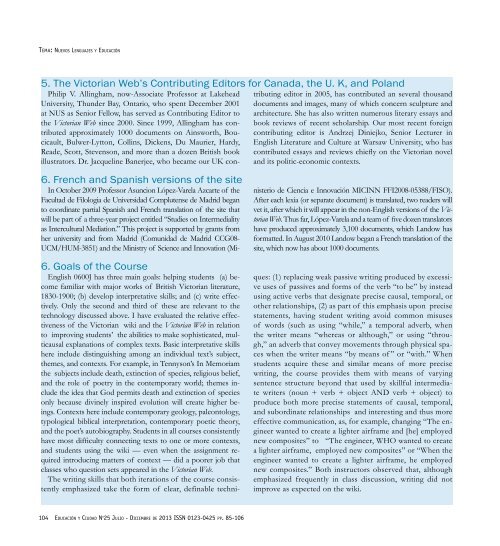Revista-Educación-y-Ciudad-No.-25
Revista-Educación-y-Ciudad-No.-25
Revista-Educación-y-Ciudad-No.-25
You also want an ePaper? Increase the reach of your titles
YUMPU automatically turns print PDFs into web optimized ePapers that Google loves.
Tema: Nuevos Lenguajes y <strong>Educación</strong><br />
5. The Victorian Web’s Contributing Editors for Canada, the U. K, and Poland<br />
Philip V. Allingham, now-Associate Professor at Lakehead<br />
University, Thunder Bay, Ontario, who spent December 2001<br />
at NUS as Senior Fellow, has served as Contributing Editor to<br />
the Victorian Web since 2000. Since 1999, Allingham has contributed<br />
approximately 1000 documents on Ainsworth, Boucicault,<br />
Bulwer-Lytton, Collins, Dickens, Du Maurier, Hardy,<br />
Reade, Scott, Stevenson, and more than a dozen British book<br />
illustrators. Dr. Jacqueline Banerjee, who became our UK contributing<br />
editor in 2005, has contributed an several thousand<br />
documents and images, many of which concern sculpture and<br />
architecture. She has also written numerous literary essays and<br />
book reviews of recent scholarship. Our most recent foreign<br />
contributing editor is Andrzej Diniejko, Senior Lecturer in<br />
English Literature and Culture at Warsaw University, who has<br />
contributed essays and reviews chiefly on the Victorian novel<br />
and its politic-economic contexts.<br />
6. French and Spanish versions of the site<br />
In October 2009 Professor Asuncion López-Varela Azcarte of the<br />
Facultad de Filologia de Universidad Complutense de Madrid began<br />
to coordinate partial Spanish and French translation of the site that<br />
will be part of a three-year project entitled “Studies on Intermediality<br />
as Intercultural Mediation.” This project is supported by grants from<br />
her university and from Madrid (Comunidad de Madrid CCG08-<br />
UCM/HUM-3851) and the Ministry of Science and Innovation (Ministerio<br />
de Ciencia e Innovación MICINN FFI2008-05388/FISO).<br />
After each lexia (or separate document) is translated, two readers will<br />
vet it, after which it will appear in the non-English versions of the Victorian<br />
Web. Thus far, López-Varela and a team of five dozen translators<br />
have produced approximately 3,100 documents, which Landow has<br />
formatted. In August 2010 Landow began a French translation of the<br />
site, which now has about 1000 documents.<br />
6. Goals of the Course<br />
English 0600J has three main goals: helping students (a) become<br />
familiar with major works of British Victorian literature,<br />
1830-1900; (b) develop interpretative skills; and (c) write effectively.<br />
Only the second and third of these are relevant to the<br />
technology discussed above. I have evaluated the relative effectiveness<br />
of the Victorian wiki and the Victorian Web in relation<br />
to improving students’ the abilities to make sophisticated, multicausal<br />
explanations of complex texts. Basic interpretative skills<br />
here include distinguishing among an individual text’s subject,<br />
themes, and contexts. For example, in Tennyson’s In Memoriam<br />
the subjects include death, extinction of species, religious belief,<br />
and the role of poetry in the contemporary world; themes include<br />
the idea that God permits death and extinction of species<br />
only because divinely inspired evolution will create higher beings.<br />
Contexts here include contemporary geology, paleontology,<br />
typological biblical interpretation, contemporary poetic theory,<br />
and the poet’s autobiography. Students in all courses consistently<br />
have most difficulty connecting texts to one or more contexts,<br />
and students using the wiki — even when the assignment required<br />
introducing matters of context — did a poorer job that<br />
classes who question sets appeared in the Victorian Web.<br />
The writing skills that both iterations of the course consistently<br />
emphasized take the form of clear, definable techniques:<br />
(1) replacing weak passive writing produced by excessive<br />
uses of passives and forms of the verb “to be” by instead<br />
using active verbs that designate precise causal, temporal, or<br />
other relationships, (2) as part of this emphasis upon precise<br />
statements, having student writing avoid common misuses<br />
of words (such as using “while,” a temporal adverb, when<br />
the writer means “whereas or although,” or using “through,”<br />
an adverb that convey movements through physical spaces<br />
when the writer means “by means of ” or “with.” When<br />
students acquire these and similar means of more precise<br />
writing, the course provides them with means of varying<br />
sentence structure beyond that used by skillful intermediate<br />
writers (noun + verb + object AND verb + object) to<br />
produce both more precise statements of causal, temporal,<br />
and subordinate relationships and interesting and thus more<br />
effective communication, as, for example, changing “The engineer<br />
wanted to create a lighter airframe and [he] employed<br />
new composites” to “The engineer, WHO wanted to create<br />
a lighter airframe, employed new composites” or “When the<br />
engineer wanted to create a lighter airframe, he employed<br />
new composites.” Both instructors observed that, although<br />
emphasized frequently in class discussion, writing did not<br />
improve as expected on the wiki.<br />
104 <strong>Educación</strong> y <strong>Ciudad</strong> N o <strong>25</strong> Julio - Diciembre de 2013 ISSN 0123-04<strong>25</strong> pp. 85-106


